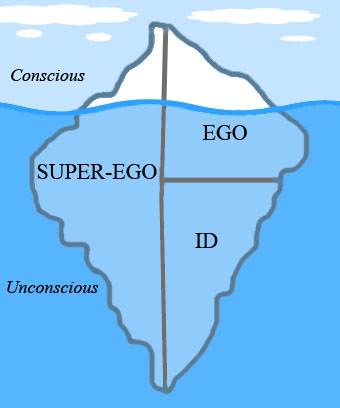

Psychodynamic therapies versus other psychological therapies for depression. The id, ego, and super-ego are a set of three concepts in psychoanalytic theory describing distinct, interacting agents in the psychic apparatus. Comparison of ego strength between aggressive and non-aggressive alcoholics: a cross-sectional study. Id: all the desires and wishes are within the id, the main goal is to achieve those things. Kovačić petrović Z, Peraica T, Kozarić-kovačić D. Freud explains that each persons personality is formed of three parts: the Ego, the. A New Conceptualization of the Conscience. The default-mode, ego-functions and free-energy: a neurobiological account of Freudian ideas. doi:10.1111/j.Ĭarhart-harris RL, Friston KJ. Identify the presence of the id, ego, and superego in literary characters previously studied by the class. In the center is the character, representing the ego, which must strike a balance between the id and superego. The superego is the part of the mind that is moral and idealistic. The ego is the part of the mind that is rational and realistic, while the id is the part of the mind that is impulsive and emotional. doi:10.3389/fpsyg.2014.00008īargh JA, Morsella E. This figure argues, 'Think about society' and encourages the character to base decisions on how well they satisfy society. The ego, id, and superego are three different parts of the mind that work together to create a person’s sense of self. An evolutionary perspective on gradual formation of superego in the primal horde.
ID SUPEREGO AND EGO FREE
Ego, drives, and the dynamics of internal objects. Free Essay: Sigmund Freud was a psychoanalytic theorist who identified three interacting parts of a persons psychological functioning Id, Ego, Superego. Ego performs both conscious, subconscious and preconscious. Ego express the impulses of id in an acceptabe way in real world. In this process, ego and superego control the drives of id in both realistic and socially acceptable ways and try to satisfy them at the appropriate place and time.

“The core set of ideas hold up,” adds Cleeremans.Boag S. People learn to control id together with development of ego and superego. While Freud’s work on sexuality and women, for example, are largely dismissed, there’s still considerable value in broad structure of his work. He’s discredited for all sorts of political reasons that have nothing to do with the ideas,” he says. The work of psychoanalysis was to strengthen the ego as Freud famously put it 10 years later, where id was, there. The id is the part of the personality that is driven by instinct and desire, while the superego is the part of the personality that represents our moral and ethical standards. As Freud proposed in The Ego and the Id, three agencies of the mind jostle for supremacy: the ego strives for mastery over both id and superego, an ongoing and often fruitless task in the face of the id’s wild passions and demands for satisfaction, on the one hand, and the superego’s crushing, even authoritarian, demands for submission to its dictates, on the other. The ego is not necessarily good or bad, but it is the part of the personality that mediates between the id and superego.
ID SUPEREGO AND EGO MOVIE
“The ‘super-ego’ in a sense is connected with meta-cognition, with the idea that in addition to first-order awareness, the technical movie that we have as soon as we wake up and the field of sensations we experience and thoughts we have, there’s an additional monitoring and control system.”Ĭleeremans believes that much of Freud’s work has scientific value today. These myths are inaccurate because the ego, id, and superego are actually all part of the same thing: the psyche. “The ‘id’ is what we call the unconscious today or the idea that there’s a vast reservoir of representations that sits there and influences ongoing processing but without being available to conscious awareness,” he says. This paper mainly analyses the the id, ego,and super-ego which exists in the main character Elizabeth from several acpects,such as her pursuit for love. In a recent lecture on metacognition at this year’s Association for the Scientific Study of Consciousness conference in Buenos Aires, cognitive psychologist Axel Cleeremans pointed out that Freud’s Id-Ego-Superego structure roughly matches onto the Unconscious-Conscious-Metacognition structure of the mind studied in neuroscience today. While Freud’s concept of the superego played a more ethical role, encouraging the id and ego to follow moral rules, its role (much like metacognition) was to impose order.


 0 kommentar(er)
0 kommentar(er)
